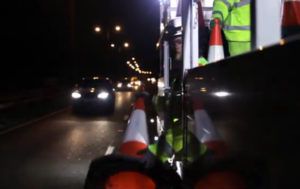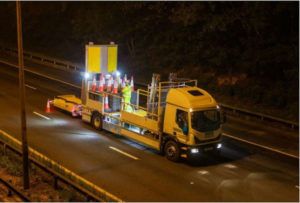Highways England (HE) is expanding its use of automated technologies with the launch of a new project to develop a machine to deploy cones on highway work zones that will help to eliminate one of the biggest risks facing the country’s roadworkers.
Cones are needed to protect road users and road workers while essential improvements or maintenance is carried out on the busy routes that comprise the agency’s Strategic Road Network (SRN). Deploying cones is currently undertaken by two people on the rear of a vehicle working in tandem. The bulk of this work is undertaken at night and carried out in most weathers, with an average 3 feet (1m) high cone weighing approximately 22lbs (10kgs). A typical 2.5 miles (4km) long closure involves putting down, and later removing, approximately 260-300 cones, meaning that two workers will both handle between 5-6 tonnes per shift in cones alone. A single mile of coning takes approximately 25 minutes to install and remove, resulting in an exposure time to live traffic of approximately two hours per shift. To date, ergonomics experts have struggled to identify a suitable method of placing and removing cones that does not have a physical impact on workers due to the twisting of the body required and environmental conditions that the work is undertaken in.
 HE and its partners are now joining forces to create automated vehicles to lay cones on the country’s motorways and major A roads. HE is working with a group of industry experts from Kier, HW Martin Traffic Management, Highway Care, and King Highway Products to develop pioneering machines that will take away the need for cones to be manually placed. The agency is funding the development and establishing a minimum standard while the companies themselves are working together in a collaborative effort to develop the vehicles that will resolve this potential safety risk and free up two workers to carry out other tasks.
HE and its partners are now joining forces to create automated vehicles to lay cones on the country’s motorways and major A roads. HE is working with a group of industry experts from Kier, HW Martin Traffic Management, Highway Care, and King Highway Products to develop pioneering machines that will take away the need for cones to be manually placed. The agency is funding the development and establishing a minimum standard while the companies themselves are working together in a collaborative effort to develop the vehicles that will resolve this potential safety risk and free up two workers to carry out other tasks.
Two automated cone laying vehicles are currently being developed with testing due to get under way next month at a centre in Lutterworth, Leicestershire. If the tests prove successful, the development companies will be able to take their vehicles to the marketplace. HE’s criteria stipulates that not only must the machines offer a safer method for highways workers, they must be safe for all road users and pose no additional risk to traffic. If they prove themselves during the trials, it is hoped both automated cone laying machines will be implemented in late 2020. HE has recently pioneered the use of other automated machines, including a road-marking robot and self-driving dump trucks.
“Safety is always the priority for us and we are constantly looking for ways to ensure everyone who works and travels on our road network is protected,” explained HE group leader, Martin Bolt, who oversees innovation in the Midlands. “By taking out the human element in the laborious task of putting out cones, we will be taking out an element of potential risk. As well as taking away this physical labour, these automated machines could also save valuable person hours and allow us to redeploy the workforce to other traffic management duties. We are delighted to be working with all of our partners to create an innovative vehicle that will make this possible.”
To see the first footage of the technology in action, click HERE and to view an HE video demonstrating the dangers of manual cone laying, click HERE






